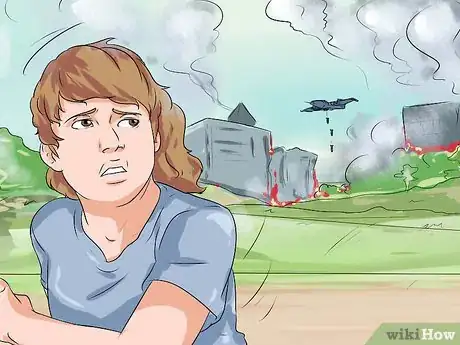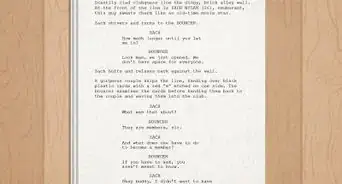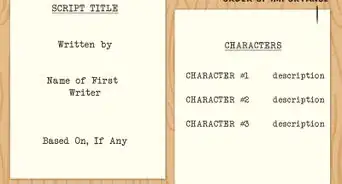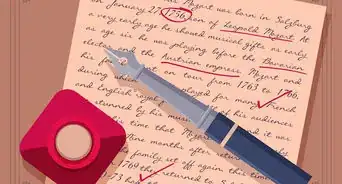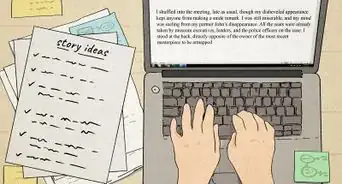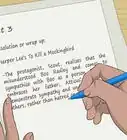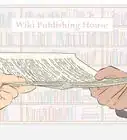This article was co-authored by Grant Faulkner, MA. Grant Faulkner is the Executive Director of National Novel Writing Month (NaNoWriMo) and the co-founder of 100 Word Story, a literary magazine. Grant has published two books on writing and has been published in The New York Times and Writer’s Digest. He co-hosts Write-minded, a weekly podcast on writing and publishing, and has a M.A. in Creative Writing from San Francisco State University.
There are 13 references cited in this article, which can be found at the bottom of the page.
This article has been viewed 34,132 times.
Are you having a hard time finding a subject or getting started on a story? Or maybe you’re having a hard time finishing? Here are some techniques and best practices that many writers use to find inspiration, get started, and finish their story.
Steps
Choosing a Story Type and Genre
-
1Decide whether you are going to write a novel or short story, screenplay or play. These forms each have their own stylistic conventions, but the same basic writing process will work for all of them.
-
2Choose a genre. The selection of genre will influence the type of story you tell and the amount of attention you give to characters, prose, and setting, respectively.[1]
- Literary fiction. Authors of literary fiction are seeking first and foremost to create a work of art. Multi-dimensional characters and the quality of prose are of primary importance, with plot sometimes a secondary consideration. Richard Russo’s Empire Falls or The Gold Finch by Donna Tartt are excellent examples of literary fiction with sparkling prose and complex characters.
- Genre fiction. While genre fiction can achieve the status of art, books in these genres are generally seen as more commercial. It is divided into many categories to help readers find the sort of books they like to read.
- Mysteries – Books about a crime, usually a murder. While a well-plotted mystery is important, it is often the characters that really make a mystery memorable. Think Sherlock Holmes, Miss Marple, or Mma Precious Ramotswe from The No. 1 Ladies’ Detective Agency.
- Thrillers – Books designed to make the reader’s pulse race and to keep him or her turning pages. Lee Child’s Jack Reacher books are a good example. Like mysteries, they are plot and character driven. They often feature a race against time, as in Dan Brown’s The Da Vinci Code.
- Romance – Books about love and romance, usually following two characters and the obstacles that keep them apart. The most successful romance writers, like Nicholas Sparks and Nora Roberts, combine interesting characters with richly detailed settings that draw the reader in.
- Fantasy – Books about imaginary worlds, usually involving magic. Setting is of primary importance. The goal, as in J.R.R. Tolkien’s Lord of the Rings or George R.R. Martin’s Song of Ice and Fire series, is to create a richly detailed world that readers want to return to again and again.
- Science Fiction – Books that imagine alternate realities or worlds based on science as opposed to magic. As with fantasy, setting is key. Books like Frank Herbert’s Dune or Isaac Asimov’s Foundation create richly imagined worlds, complete with their own climate, politics, religion, food, and technology.
- Historical – Books that are set in the past, combining elements of fiction with accurate details of the time period. They tend to emphasize plot and setting. The best historical fiction – like Robert Graves’ I, Claudius or Hilary Mantel’s Wolf Hall – recreates the past so convincingly, the reader forgets they are reading fiction.
- Horror – Books that create a feeling of terror or dread in the reader, often incorporating supernatural elements. These books emphasize plot and tone. Stephen King’s books are the gold standard.
- Young Adult – Books that are for and about teenagers and pre-teens (12-18 years old). They are usually combined with another genre, often romance or fantasy. This field has grown rapidly of late, with series like Harry Potter and The Hunger Games transcending the genre to become bestsellers.
Advertisement -
3Pick a genre that you enjoy reading. The more familiar you are with a genre, the easier it will be for you to conform to (or strategically break) the rules that define it.
Finding a Story Idea
-
1Write to find ideas. Coming up with a good idea is a process, not an event. There is rarely an “ah-ha” moment. The best way to develop an idea is to start somewhere – a place, character, even a great title – and start writing. What makes and idea good is putting in the time necessary to develop the characters, plot, and setting.[2]
- J.K. Rowling’s Harry Potter and the Sorcerer’s Stone is a good example of a wonderful idea that was built over time, rather than conceived all at once. The basic idea – an eleven year old boy is invited to attend a magical school for wizards, where he must confront the evil that killed his parents – is fine, but there is nothing great about it. What makes the book work is the details that grew from that idea: Hogwarts with its talking pictures and moving staircases; owls delivering mail; Quidditch; Bertie Bott’s every flavor beans… One could go on and on.
-
2Start with “what if". What-if statements are great story generators. What if the capitol was bombed during the State of the Union Address? What if you learned you were adopted? What if the young couple living next door were actually Russian spies? Start by creating a long list of what-ifs, then flesh out the ones with the most promise.
-
3Use the genre to help you get started. If you are writing literary fiction, you might want to start with your central character. What does he or she do? What is his or her personality? What is the conflict they are facing? If you are doing fantasy or sci-fi, think about the world you want to create. If you are doing an historical work, think about the period, event, or character you want to build your story around. If you are writing a mystery, think about the crime.
-
4Pay attention to current events. Stories like Michael Crichton’s Jurassic Park started as a piece of news. Human struggle, invention, and quirky characters abound in the real world. The news is one good place to find them.
-
5Watch the world around you. That vacant lot you pass every day on the way to work might be the start of a story. What if you found a suitcase full of cash there? Or think up a story to explain why the couple at the next table is sitting in stony silence.
-
6Look to your own life for inspiration. Perhaps you have traveled somewhere that you think would be a great setting for a story, or met someone who would make an interesting character. Maybe you do an interesting job. Or perhaps you have been through a powerful experience – war, cancer, a break up – that could provide the basis for a story.
-
7Reinvent a scene from a book. Take a small, relatively unimportant scene from a favorite film or novel, and then imagine it as the opening scene to your story. Be sure to change the characters; the goal is to give you a starting point, not to plagiarize.[3]
-
8Modify stories you know. Take the plot summary of a story you know and change it one bit at a time until you have your own story idea to flesh out.[4] Try Casablanca. Here’s the summary from imbd.com: “Set in unoccupied Africa during the early days of World War II: An American expatriate meets a former lover, with unforeseen complications.” What if you changed the setting to Saigon during the early years of the Vietnam war? What if you made the lead character a woman? And she had ties to the Viet Cong, instead of the French Resistance?
-
9Invent a history for someone you have lost touch with. Maybe you have a best friend from grade school, high school or college you haven’t spoken to in years. Or a worst enemy. Imagine the life they have led since.[5]
-
10Use a writing prompt. There are dozens of lists out there on sites like Writer’s Digest or Creative Writing Now. Remember: it doesn’t matter where you start; what matters is where you take the idea.
-
11Keep a notebook by your side at all times. That way if you get any ideas, you have a fast and easy to way to jot them all down before you forget.
Researching your Story
-
1Don’t think you can skip this step. Even if you are writing fantasy (especially then!), you will need to do research before you start writing.
-
2Research your characters. If you are writing an historical novel using real characters, then you will need to research their lives. The more famous the character, the more research you will need to do. But even if your characters are fictional, you’ll still need to do creative research.
- Give your characters a personality. Pick their virtues and flaws. Are they funny? Easily angered? Smart? Sly? A compulsive gambler? What are their mannerisms? Remember, the most interesting characters are rounded – not 100% good or bad.[6] Think of Sherlock Holmes – brilliant, but also an egotistical drug addict. Or Elizabeth Bennet from Jane Austen’s Pride and Prejudice – smart, independent minded, and funny, but also proud and condescending.
- Work on your character’s appearance. You’ll need to know their body type, eye color, skin and hair color, the shape of their face, and if they have any distinguishing birthmarks or scars. Don’t forget less obvious features, too, like long, delicate fingers or impossibly skinny legs with knobby knees. Remember, it is often effective to create a character who’s appearance belies their personality.[7]
- Hilary Mantel is a master of character description. Take her Cardinal Wolsey from Wolf Hall: “The cardinal, at fifty-five, is still as handsome as he was in his prime. Tonight, he is dressed not in his everyday scarlet, but in blackish purple and fine white lace: like a humble bishop. His height impresses; his belly, which in justice should belong to a more sedentary man, is merely another princely aspect of his being, and on it, confidingly, he often rests a large, white, beringed hand. A large head—surely designed by God to support the papal tiara—is carried superbly on broad shoulders: shoulders upon which rest (though not at this moment) the great chain of Lord Chancellor of England.”
- Pick a name. You can pick any name you want, but if you are writing historical fiction, you may want to check the Medieval Names Archive (which also covers pre-medieval names) to make sure your names are historically accurate.
- Flesh out your characters. Think of their hobbies, profession, background, and upraising. How do they relate to their friends? Their family? Do they like their job? What kind of clothes do they wear? How do they talk? Are they clumsy or graceful?[8]
- Remember that character development is an ongoing process. You’ll want to research your characters before you start writing, but they probably won’t really come to life until you are well into your story.
-
3Research your setting. If you have a place in mind, use it. If not, you’ll need to pick a place that is appropriate to the story you are trying to tell. If your setting is fictional, that means even more work.[9] You’ll have to create an interesting, believable world. One good way to do so is to borrow details from real world settings. George R.R. Martin’s Song of Ice and Fire does this masterfully, combining elements of medieval Nordic and English culture, with bits from Mongolia, China, Spain, and beyond.
- Where do you see your story? A city or town? Urban or rural? Arctic or tropical? Is it embedded in a particular culture, like feudal Japan or revolutionary France? Don’t just set your book anywhere; make the setting a vital part of the novel.
- Research places that fit that description.
- Fill in the details. Once you know where your story will be set, you’ll want to know things like the location's history, its climate, the style of architecture, and the local culture and religion. Do enough work up front to get started, but don’t overdo it. You can look up more details as needed while you write.[10]
- A rich setting can serve almost as another character, as in Graham Swift’s atmospheric novel Waterland: “We lived in a lock-keeper’s cottage by the River Leem, which flows out of Norfolk into the Great Ouse. And no one needs telling that the land in that part of the world is flat. Flat, with an unrelieved and monotonous flatness, enough of itself, some might say, to drive a man to unquiet and sleep-defeating thoughts. From the raised banks of the Leem, it stretched away to the horizon, its uniform color, peat-black, varied only by the crops that grew upon it – grey-green potato leaves, blue-green beet leaves, yellow-green wheat; its uniform levelness broken only by the furrowed and dead-straight lines of ditches and drains, which, depending on the state of the sky and the angle of the sun, ran like silver, copper or golden wires across the fields, and which, when you stood and looked at them, made you shut one eye and fall prey to fruitless meditations on the laws of perspective.”
Writing your Story
-
1Make a schedule. Set aside time – preferably in at least two hour chunks – when you will write. Stick to your schedule. This is the easiest way to ensure you finish your project.
- Don’t worry about daily or weekly page or word quotas. Failing to meet you quota can leave you upset and not wanting to write.
- Remember: some days you will write a lot; others you will write very little. In both cases, you are doing work. Just put in the time, and you’ll get there!
-
2Write whatever kind of outline works best for you. An extremely detailed outline can make writing easier, but some writers feel it limits their creativity. Here are a few types of outline:
- A synopsis – A good synopsis covers the major plot points of a novel without going into too much detail regarding the setting, characters or dialogue. Writing a synopsis is good practice for novelists and screenwriters alike, as synopses are often used to pitch new book or movie ideas to editors and producers.
- Chapter by chapter or scene by scene – Write one or two sentences for each chapter or scene in the book or screenplay you are writing. This can be particularly helpful in keeping your story from becoming too long.
- A collection of scenes – Write out the key scenes in your story: pivotal plot points or character developments. When it comes time to write the story, you can use these key scenes as guideposts, writing from one to the next.[11]
-
3Don’t obsess over your first draft. The goal of the first draft is to finish. You’re just trying to get the basic plot in place and find your character’s voices. It does not need to be perfect.[12]
-
4Don’t let writer’s block slow you down. Every writer gets stuck from time to time. Maybe you can’t find a way to move a scene forward, or feel like your writing is poor that day. Waiting for inspiration is not the answer. Here are some effective ways to overcome writer’s block:
- Take a short break. Take a walk, grab some coffee, or read. A few minutes thinking about something else can really help.
- Switch between computer and pen and paper. Sometimes changing the medium you are writing in will help get you started.
- Write in outline form, focusing only on blocking and dialogue. Not worrying about your prose will leave you free to concentrate on character and plot. You can then flesh out the prose later.[13]
- Freewrite. Sit down and write everything you can think of about your story and character. Even if you don’t fix the scene you are currently working on, you will be doing useful work.
- Write what you are excited about. If you are stuck, simply move on. Pick another part of the story that excites you and start there.
-
5Write multiple drafts. It is hard to nail down your plot, character development, overarching themes, and prose all at the same time. Trying to do too much is a key source of writer’s block. Take it easy on yourself and try writing at least three drafts, preferably four.
- Draft 1 – Focus on getting to “The End”. Plot should be your major concern. Don’t waste time trying to perfect everything; instead, make a list of changes you want to make for draft 2.
- Draft 2 – Apply your list of changes and nail down the plot. This is a good time to make a reverse outline: working off your first draft, write a sentence or two for each scene or chapter. It will help you identify slow points, dead weight, or problems in overall structure.[14]
- Draft 3 – Focus on your characters and overarching themes. It takes time to find your characters; voice. Now is the time to make certain that voice is consistent.
- Draft 4 – Polish your prose. There is no sense dong this in the early drafts, because you will end up cutting much of what you write. So save the polishing until you are satisfied with your plot and characters. And don’t forget these four key editing tips:
- Make sure your descriptions are vibrant (“she had emerald eyes and smooth, golden skin the color of the desert sands,” not “she was beautiful”).
- Show, don’t tell (“his jaw clinched,” not “he was angry).
- Be wary of adverbs; they are rarely necessary (“she sauntered” instead of “she walked slowly).
- Avoid clichés.
-
6Show your story to people. You can seek feedback in a number of ways: friends and family, automated critique software, posting the manuscript on a fiction website or a critique website, joining a writing group, or doing a writing course.[15] .
-
7Use the feedback to improve your story. Remember: readers are usually right when pointing out problems, but often wrong when suggesting solutions. It is up to you to provide solutions that both satisfy readers and honor your creative vision.[16]
Expert Q&A
Did you know you can get expert answers for this article?
Unlock expert answers by supporting wikiHow
-
QuestionHow do I make a good setting for my story?
 Grant Faulkner, MAGrant Faulkner is the Executive Director of National Novel Writing Month (NaNoWriMo) and the co-founder of 100 Word Story, a literary magazine. Grant has published two books on writing and has been published in The New York Times and Writer’s Digest. He co-hosts Write-minded, a weekly podcast on writing and publishing, and has a M.A. in Creative Writing from San Francisco State University.
Grant Faulkner, MAGrant Faulkner is the Executive Director of National Novel Writing Month (NaNoWriMo) and the co-founder of 100 Word Story, a literary magazine. Grant has published two books on writing and has been published in The New York Times and Writer’s Digest. He co-hosts Write-minded, a weekly podcast on writing and publishing, and has a M.A. in Creative Writing from San Francisco State University.
Professional Writer How you'll research your setting depends on where your story takes place, but if it's possible, try to spend time in the location. If your fictional world is set in a hospital, for instance, go spend some time in a hospital and take notes. Don't just rely on your memory of times you might have visited a hospital before—sit down and observe people, observe the setting, and write down precise details.
How you'll research your setting depends on where your story takes place, but if it's possible, try to spend time in the location. If your fictional world is set in a hospital, for instance, go spend some time in a hospital and take notes. Don't just rely on your memory of times you might have visited a hospital before—sit down and observe people, observe the setting, and write down precise details. -
QuestionI have been writing for 6 years now, but I feel like if I write, my stories will be a rip off of another book. Please help?
 Community AnswerA lot of stories are actually very similar, if you think about it. There are only a few different plots and people just make various changes so that their version is unique. Don't overthink it. Write your story, and if it seems to similar to something else when you're done, just make some changes.
Community AnswerA lot of stories are actually very similar, if you think about it. There are only a few different plots and people just make various changes so that their version is unique. Don't overthink it. Write your story, and if it seems to similar to something else when you're done, just make some changes. -
QuestionI have very many exciting ideas for my novel, but I don't know where to start from. Each sentence I write doesn't reach my expectations. How can I solve this problem?
 KY_GirlatHeartCommunity AnswerAll those ideas provide wonderful fuel for writing! I would suggest that you don't be concerned about what you put down. When you finally finish your novel, you can edit it after letting it sit for a few days, weeks, etc. For now, focus on getting down what you need to get down. Editing it as you go or freaking out over sentences won't get your novel done; first drafts are first drafts for a reason.
KY_GirlatHeartCommunity AnswerAll those ideas provide wonderful fuel for writing! I would suggest that you don't be concerned about what you put down. When you finally finish your novel, you can edit it after letting it sit for a few days, weeks, etc. For now, focus on getting down what you need to get down. Editing it as you go or freaking out over sentences won't get your novel done; first drafts are first drafts for a reason.
References
- ↑ http://www.creative-writing-now.com/types-of-novels.html
- ↑ http://fictionwriting.about.com/od/crafttechnique/a/How-To-Get-Story-Ideas.htm
- ↑ http://www.writersdigest.com/online-editor/5-ways-to-come-up-with-great-story-ideas
- ↑ http://www.how-to-write-a-book-now.com/writing-ideas.html
- ↑ http://www.writersdigest.com/online-editor/5-ways-to-come-up-with-great-story-ideas
- ↑ http://www.writersdigest.com/writing-articles/by-writing-goal/write-first-chapter-get-started/hooked-on-a-feeling
- ↑ http://referenceforwriters.tumblr.com/post/49480008597/developing-your-characters-and-making-them
- ↑ http://referenceforwriters.tumblr.com/post/49480008597/developing-your-characters-and-making-them
- ↑ http://www.novel-writing-help.com/fictional-settings.html
- ↑ http://blog.janicehardy.com/2011/01/lets-get-ready-to-write-researching.html
- ↑ http://www.creative-writing-now.com/novel-outline.html
- ↑ http://thewritepractice.com/write-story/
- ↑ http://goinswriter.com/how-to-overcome-writers-block/
- ↑ http://opinionator.blogs.nytimes.com/2013/01/21/outlining-in-reverse/?_r=0
- ↑ http://graemeshimmin.com/getting-feedback-on-your-novel/
- ↑ http://graemeshimmin.com/getting-feedback-on-your-novel/
About This Article
To write an original story, start by putting together an outline you can use to guide your writing, like a synopsis or a chapter-by-chapter description. Then, write your first draft by focusing on just the main plot and primary characters with the goal of getting all the way through the story. If you get stuck at any point, try switching between pen and computer, free-writing, or taking a break. Once you complete the first draft, write several more, soliciting feedback between drafts and working on different aspects of your story in each new version. For tips on how to come up with an idea for your original story, scroll down!






